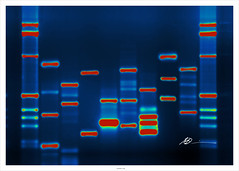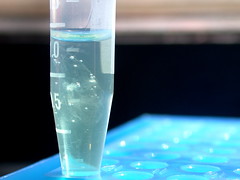by
Tabetha Cooper
In criminal cases, DNA is an effective and accurate evidentiary tool that aids in conclusively convicting the guilty or freeing the innocent. The art of DNA analysis originated in the 1980's and has since become a routine part of all investigations.
 |
| Micah's DNA (Photo credit: micahb37) |
Since DNA analysis has aided in solving so many cases, it is now mandatory for convicted person to submit a DNA sample for future comparison. Since this endeavor has become successful it is now being debated as to whether a person arrest but not yet convicted should be made to submit a DNA sample. After the sample has been collected it is stored in a database called CODIS where it can be run among other DNA samples found at past crime scenes and stored for use in impending investigations. This wonderful scientific discovery and its wide spread use has raised ethical questions regarding privacy when comes to mandating the not yet convicted to submit a sample of their DNA. Upon understanding what DNA is, its use, and hearing arguments on both sides of this issue, I am sure that you will find mandating arrestee’s to submit a DNA sampling to a useful procedure.
Deoxyribonucleic acid or DNA is the molecule that represents a person's unique genetic makeup. It can be found in any cell with a nucleus and is the same within each cell of a person's body. It has four identifying bases that are sequenced individually for each person (except for identical twins). The bases are Cytosine (C), Guanine (G), Thymine (T), and Adenine (A). In 1985, Dr. Alec Jefferys explained how these bases repeat in unique sequences to each individual and how based on these sequences a person paternity, or in the field of criminal justice, involvement in a crime could be determined based upon these sequences. (www.dna.gov)
 |
| DNA (Photo credit: Gravitywave) |
In an investigation, evidence is collected in an attempt to identify the perpetrator of the crime. Among this evidence can be any number of DNA containing cells. DNA can be found in hair, bone, teeth, fingernails, blood, semen, urine, feces,
sweat, saliva, mucus membranes, skin cells, muscles, organs, and brain cells. As it can easily be seen, with the vast array of places DNA can be found, it is quite impossible to do anything in life and not leave a least a trace amount of it behind. When DNA tested first started in the 1980's it took a large amount of it to get a profile but with the advances in technology within the last twenty-five years all it takes is a very minute amount to get a conclusive DNA profile. After DNA evidence has been analysis it is compared to known suspect samples in a case. If there are no known samples it is ran through a DNA database called Combined DNA Index Systems or CODIS. There, the sample can be compared to known offenders as well as to other crimes that may have the same DNA evidence, linking the two crimes. CODIS is used in many different jurisdictions from local, state, to federal agencies. In the event that no match is immediately made an automatic search will be done weekly. If a DNA match is made during that search, the results will be sent to the agency that submitted the DNA sample for comparison. (www.dna.gov)
 |
| English: tSMS DNA sample sequencing: image templates and cleave (Photo credit: Wikipedia) |
Because of the success with DNA evidence, both in convicting guilty perpetrators and exonerating the innocent who have been sitting in prison for years, most states require that offenders submit a DNA sample upon conviction. According to Berson (2009), courts have continued to uphold the ruling that a convicted person should have to submit a DNA sample. She goes on to explain that the controversy has now targeted arrestees who have not yet been convicted of a crime. DNA is collected from an offender by taking a swab from the inner cheeks of an offender's mouth. It has been debated about whether this is ethical and even constitutional when an offender hasn’t even been convicted of a crime by a jury of his peers. After all isn’t he still protected by the Bill of Rights?
DNA can determine more than merely if a person perpetrated or at the very least was at the scene of a crime. DNA can be used to establish paternity and be used for a number of other medically related things. Due to the ability to determine these other things it raises the question of intrusion upon privacy. It can be argued that mandatory DNA samples go against the U.S. Constitution and the Bill of Rights. The Fourth Amendment guarantees the protection of privacy of person and possessions against unreasonable searches and seizures and the Fifth Amendment against self-incrimination and the privacy of personal information. (topics.law.cornell.edu).
 |
| CODIS (Combined DNA Index System) logo (Photo credit: Wikipedia) |
On the other hand, as Berson (2009) states, DNA sampling is the same as fingerprinting. When a suspect has been arrest it is part of the booking procedure to fingerprint him. If he is later found innocent he has the option of asking for his fingerprints to be taken off the books. If mandatory DNA sampling was part of the booking process and the suspect was later found guilty he could then ask for the fingerprint and the DNA sample to be removed from the records. Privacy is an issue because so much information can be received from a DNA sample. Medical records could be breached. Most crime laboratories are not concerned with nor equipped to gain medical information. There is no personal information in regards to physical attributes when DNA results are entered into a database.
With the success that has come from mandating convicted offenders to enter their DNA, a person could only infer that mandating arrestee’s to submit a sample of their DNA would only bring that more results. With a complete understanding of what DNA is and how it can be used most people have to agree that the more samples that we can compare DNA evidence to the more criminals we can get off the street. This will make our communities a safer place for future generations. DNA is a biometric feature as with a fingerprint, it can link a particular person to a particular crime due to the characteristics that make
it individual to each person. The difference with DNA evidence is that it can be done more conclusively and with less room for error.
References
Berson, Sarah B. (2009) Debating DNA Collection. Retrieved May 12, 2010, from
Foster, R.E. (2000). Police Technology. Upper Saddle River: Pearson Prentice Hall
http://www.dna.gov/basics/













0 comments:
Post a Comment